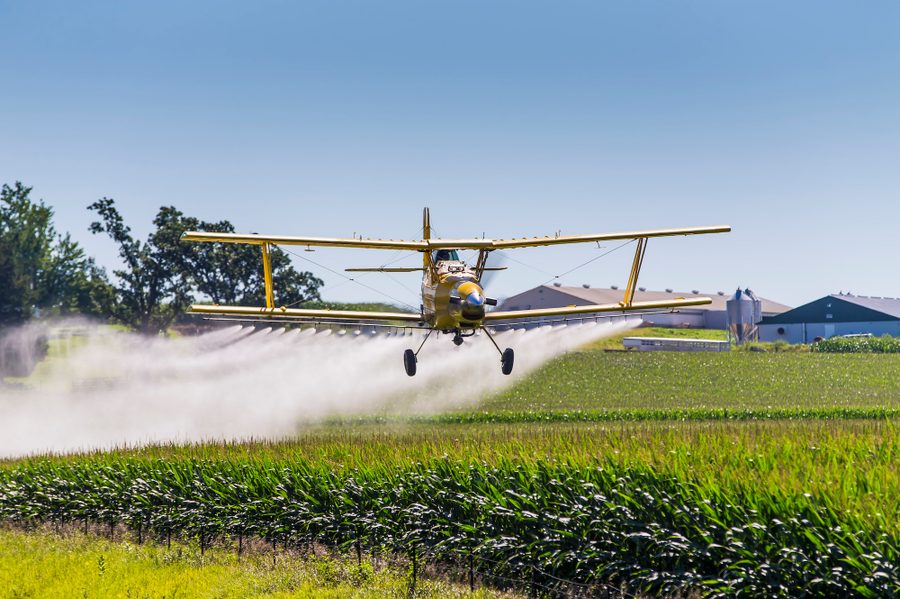Study: Because of Pesticides, Living in Farm Towns Is as Risky as Smoking
New research shows that the pesticides used heavily by industrial agriculture contribute to inflated cancer risk in farm country, “with few areas spared.”
Shannon Kelleher

Editor’s Note: This article was originally published by The New Lede.
People who don’t farm, but live in U.S. agricultural communities where pesticides are used on farms, face an increased cancer risk as significant as if they were smokers, according to a new study.
The study, published July 24 in the journal Frontiers in Cancer Control and Society, analyzed cancer incidence data from nearly every U.S. county and looked at how that data corresponded to federal data on agricultural pesticide use. Researchers reported that they found the higher the pesticide use, the higher the risk for every type of cancer the researchers looked at.
“Agricultural pesticide use has a significant impact on all the cancer types evaluated in this study (all cancers, bladder cancer, colon cancer, leukemia, lung cancer, non-Hodgkin lymphoma, and pancreatic cancer), and these associations are more evident in regions with heavy agricultural productivity,” the study states.
“Pesticide-associated cancers appear to be on par with several smoking-associated cancer types,” the study states. It has been well established that smoking increases cancer risk, with at least 70 of the thousands of chemicals in tobacco smoke considered carcinogens.
The findings add to a wealth of research on pesticides and human health risks that point to shortcomings in U.S. pesticide regulations, said Dana Barr, an environmental health researcher at Emory University who was not involved in the study.
“Right now, I don’t think the regulations for pesticides are the most health-protective, and they seem to presume that a chemical is safe until it is proven toxic, not the other way around,” Barr said. “I do think we need policy reform that puts the onus on the manufacturers to do a better job of evaluating safety before allowing new registrations.”
The authors said they analyzed U.S. Geological Survey (USGS) data available for 69 pesticides in thousands of counties along with cancer data from the National Institutes of Health (NIH) and the Centers for Disease Control (CDC).
“We naively thought some of the cancer [risk] rates would not be affected,” said Isain Zapata, associate professor at the Rocky Vista University’s College of Osteopathic Medicine in Colorado and an author of the study. “That was where we found our surprise,” he said.
“We talk about pesticides being bad, we have examples of specific pesticides having some very extreme effects,” said Zapata. “But… it doesn’t affect only people that are exposed directly while working with [pesticides].”
Beyond farmers
Previous research has linked pesticides to numerous cancers.
Glyphosate, the active ingredient in the weedkiller Roundup and the most widely used herbicide in the world, has been classified as a probable human carcinogen by the International Agency for Research on Cancer (IARC).
More than 100,000 plaintiffs sued Monsanto and owner Bayer AG alleging exposure to Roundup and related products caused them to develop non-Hodgkin lymphoma. The U.S. Environmental Protection Agency (EPA) maintains there is no evidence that glyphosate causes cancer in humans.
Dicamba, an active ingredient in several other popular weed killers, was linked to numerous cancers in a 2020 NIH study. In February, a federal judge in Arizona banned three dicamba-based weed killers made by Bayer, BASF and Syngenta and ruled that the EPA broke the law by allowing their use.
This new study published is not a part of the long-running Agricultural Health Study, which is a collaboration by the National Cancer Institute, the National Institute of Environmental Health Sciences and the EPA. Since 1993, the AHS has been studying cancer and other health outcomes in 89,000 licensed pesticide applicators and their spouses in North Carolina and Iowa.
In 2022, the AHS announced it had found increased kidney cancer rates in farmers who frequently used certain pesticides, including chlorpyrifos, paraquat and atrazine, as well as increased thyroid cancer rates in farmers who sprayed the insect-killer lindane and in those using the fungicide metalaxyl.
But while the Agricultural Health Study has made many contributions to knowledge about the link between pesticides and cancers in farmers, it does not account for people who live in agricultural areas but do not farm.
“Our study aims to fill in that gap,” the new assessment states.
“Few areas spared”
To understand how much pesticide use contributes to cancer risk in different U.S. regions, Zapata and colleagues first ran a statistical analysis to map patterns of agricultural pesticide use across the U.S. using USGS county-level data. Next, they used CDC and NIH data to determine how these pesticide-use patterns corresponded with cancer incidences.
They observed the greatest elevated risk in states known for high corn production, including the top U.S. corn growing state of Iowa, along with Illinois, Nebraska, Missouri, Indiana and Ohio.
The study noted, however, that the effects of pesticide exposure were “spread out through the country with few areas spared.”
While the studies focused on pesticide usage as a whole, it also found that some specific chemicals contributed more to a county’s cancer risk than others. For example, higher risks of colon and pancreatic cancer were found in regions where dicamba was popular, while higher cancer risk in general, as well as colon and pancreatic cancer, specifically, were observed in regions where glyphosate was widely used.
“We need to educate people,” said Zapata. “We need to continue doing research so we have better ways of using these products or evaluating the effects of these products.”
Shannon Kelleher is a staff reporter at The New Lede.




